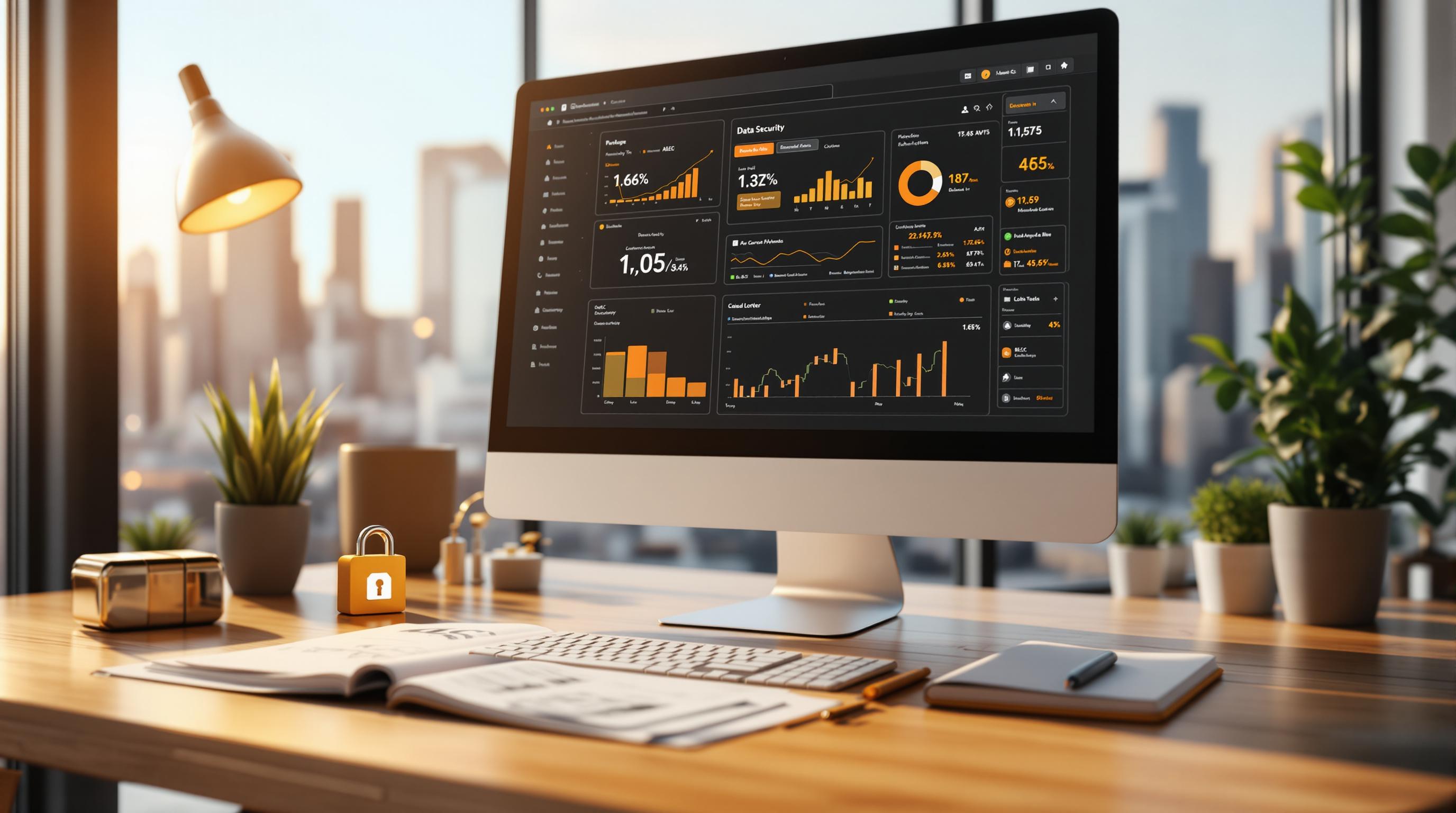Data Security in AEC Software: Protecting Intellectual Property and Client Information
Taher Pardawala April 15, 2025
Cyberattacks are a growing concern for the AEC (Architecture, Engineering, and Construction) industry. Here’s what you need to know:
- 59% of AEC firms faced cybersecurity threats in the last two years.
- Inadequate security cost the global construction industry $1.85 trillion in 2020.
- Collaborative tools like BIM (Building Information Modeling) are prime targets for data breaches.
Key Risks to Watch:
- File Sharing Issues: Mishandled files and insecure sharing methods.
- Cloud Configuration Errors: Weak encryption and access controls.
- Internal Access Problems: Poor management of permissions.
Solutions You Can Implement:
- Encrypt Data: Use AES-256 and TLS 1.3 for secure storage and transmission.
- Control Access: Implement role-based permissions and two-factor authentication (2FA).
- Monitor Activity: Track file access, set alerts for unusual behavior, and conduct regular audits.
By combining encryption, access controls, and team training, AEC firms can protect sensitive data and intellectual property. Stay ahead of evolving threats with proactive security measures.
How AI-Powered Cyber Attacks Are Putting Construction …
Common Security Risks in AEC Software
As digital collaboration grows in the AEC industry, so do the security challenges. Protecting intellectual property and sensitive client data is more important than ever. Below are some of the most common vulnerabilities that require attention.
File Sharing Vulnerabilities
File sharing is a major weak spot in AEC workflows. Many breaches happen because files are mishandled, especially in remote work settings [1]. Using traditional email attachments or basic cloud storage often lacks the necessary security features, putting design files and project details at risk. A particular issue arises when sending files to multiple recipients – recipient details can become visible, unintentionally exposing confidential project information [1].
Cloud Configuration Issues
Poorly set up cloud systems can create serious risks. Weak access controls or inadequate encryption are common missteps that can leave project data exposed. These errors not only compromise security but can also lead to financial losses for firms in the industry [1].
Internal Access Challenges
Managing who can access what within a project is no small task, especially with so many stakeholders involved. Proper access permissions, clear data retention policies, and secure disposal methods are essential for protecting data throughout a project’s lifecycle.
Emerging Security Threats in AEC
The use of AI in AEC workflows has streamlined project management and design but has also introduced new risks [2]. Remote work has further amplified vulnerabilities, with human error playing a bigger role in breaches. Examples include accidentally sharing sensitive data, using unsecured collaboration tools, or setting file permissions incorrectly. These evolving threats highlight the need for robust security measures to protect both intellectual property and client data in AEC software systems.
Addressing these risks is key to maintaining secure and efficient workflows while safeguarding critical information.
Data Protection Methods
Develop strong data protection measures to safeguard intellectual property and client information within AEC software.
Data Encryption Steps
Encrypting data prevents unauthorized access and ensures sensitive information remains secure [3].
1. Evaluate Your Data
Identify the types of data that require encryption, such as:
- Project blueprints and technical specifications
- Client financial details
- Proprietary design components
- Contractual documents
2. Select Appropriate Encryption Techniques
- Use AES-256 for encrypting stored files
- Implement TLS 1.3 for securing data during transmission
- Apply end-to-end encryption for real-time collaborations
3. Manage Encryption Keys Securely
- Store decryption keys separately from the encrypted data
- Maintain secure backups of both keys and encrypted files
Once encryption is in place, managing access to this data becomes the next critical step.
User Access Controls
Laurent Villeneuve of Genetec, Inc. highlights that database-level encryption paired with well-defined access roles minimizes data exposure [4].
| Access Level | Permissions | Typical Roles |
|---|---|---|
| Full Access | Complete data control | Project Managers, System Administrators |
| Modified Access | Edit specific data | Design Team Leaders, Engineers |
| View Only | Read-only access | Clients, Contractors |
| No Access | No data access | External Vendors |
To enhance security, implement two-factor authentication (2FA) across all access levels.
2-Factor Authentication Setup
Research from Google indicates that device-prompt 2FA can block 100% of automated bot attacks [5].
- Use authenticator apps instead of SMS for verification
- Deploy hardware security keys for critical access points
- Offer backup authentication options for emergencies
- Mandate 2FA for accounts handling sensitive project data
Activity Tracking Systems
"Lateral movement can be restricted with policies that prevent any one individual from having unnecessary access. Cybersecurity should be front-of-mind for everyone, rather than consolidated under a few individuals. As with most security, safeguards must be driven from an overall organizational philosophy in concert with practical, technical safeguards" [4].
Key components of activity tracking include:
- Monitoring file access and changes in real time
- Setting up automated alerts for unusual activities
- Conducting regular security audits
- Recording user sessions during sensitive operations
These measures ensure a proactive approach to identifying and addressing potential security risks.
Cloud Storage Security for AEC
Using strong data encryption and access control measures, secure cloud storage plays a key role in protecting AEC software systems. When properly secured, cloud storage allows AEC teams to store design files, collaborate safely, and access project data from any device.
Benefits of Secure Cloud Storage
Here are some key benefits of using secure cloud storage:
- Encrypted file sharing enables real-time collaboration without compromising security.
- Centralized access control ensures only authorized users can view or edit files.
- Audit logging helps track file access and changes for better oversight.
Choosing the Right Cloud Provider
To maximize these benefits, it’s crucial to choose a cloud provider that prioritizes security. Look for providers offering the following features:
| Security Feature | Purpose | Priority |
|---|---|---|
| File-level Encryption | Protects individual files | Critical |
| Access Controls | Manages user permissions | Critical |
| Audit Logging | Tracks file access and changes | High |
"Encrypting your files before they reach the cloud is the single most important precaution to take." – Asaf Cidon, co-founder and CEO of Sookasa [6]
Best Practices for Cloud Security
Follow these steps to maintain secure cloud operations:
- Data Encryption
Encrypt data at every stage – whether in transit or at rest. Keep encryption keys stored separately for added security. - Access Controls and File Sharing
Use strict access controls to limit who can view or edit files. For external collaborations, rely on encrypted links to securely share data. - Monitoring and Auditing
Regularly monitor file activities and maintain comprehensive audit logs. Set up automated alerts to flag suspicious behavior.
"Limiting access on a need-to-know basis is a good practice, because it decreases the risk that, say, someone will stumble upon a file that they shouldn’t see and accidentally email it to someone who shouldn’t have it." – Asaf Cidon, co-founder and CEO of Sookasa [6]
sbb-itb-51b9a02
Meeting Industry Standards
Strengthening cloud and data protection measures is just the start – aligning with regulatory standards is another critical step in securing AEC software. Compliance plays a key role in safeguarding intellectual property and sensitive client information. A recent study found that 82.45% of U.S. residents are concerned about how personal data is used to train AI systems [8].
AEC Security Rules
To meet these standards, AEC software must follow specific regulations and implement focused security practices:
| Standard/Regulation | Key Requirements | Implementation Focus |
|---|---|---|
| ISO/IEC 27001:2022 | Information Security Management | System-wide security controls |
| SOC 2 Type II | Data handling and privacy | Access management and monitoring |
| NIST SP 800-53 | Federal security controls | Comprehensive security framework |
| US Copyright Law | Design protection | Intellectual property safeguards |
These practices help address regulatory demands while reducing security risks:
- Enforcing multi-factor authentication for access
- Using encryption that meets compliance standards
- Offering 99.99% uptime through service level agreements
"For companies that are developing AI and thinking about using AI, using a risk-management framework is an important first step."
– Aaron Cooper, VP of global policy, BSA | The Software Alliance [8]
Security Check Schedule
Regular evaluations are key to maintaining compliance and staying ahead of new threats. Research shows that 62% of professionals in construction are increasingly aware of the risks tied to AI misuse [8].
- Monthly Assessments
Perform monthly vulnerability scans and access reviews, following NIST guidelines [9]. - Quarterly Audits
Review key areas every quarter, including:- Data encryption protocols
- Access logs
- Vendor security compliance
- AI system risk evaluations
- Annual Compliance Review
Conduct a thorough yearly audit to cover:
"Regulations that are clear, consistent, and not overly burdensome will allow companies like ours to focus on innovation while ensuring the ethical and secure use of AI."
– Pratyush Rai, CEO of Merlin AI [8]
Building Team Security Awareness
Once your systems and data are secure, the next step is empowering your team. Why? Because human error is one of the leading causes of security breaches in the AEC industry. By combining team awareness with technical defenses, you create a stronger shield for your designs and client information.
Security Training Program
A structured training program tailored to AEC-specific challenges is a must. Here’s a breakdown:
| Training Component | Focus Areas | Implementation Timeline |
|---|---|---|
| Basic Security | Password management, safe data handling | Monthly refresher |
| Advanced Protection | Safeguarding intellectual property and client data | Quarterly updates |
| Incident Response | Breach reporting and response protocols | Bi-annual drills |
| Compliance Updates | Changes in regulations and security standards | Annual certification |
Security Policy Creation
Training is just the start. Clear, actionable policies are essential to reinforce your security framework. Here’s what to focus on:
1. Risk Assessment Framework
Identify and document threats specific to AEC software systems. This includes risks like unauthorized access to design files, intellectual property theft, and vulnerabilities in cloud storage.
2. Access Control Guidelines
Set strict rules to ensure team members can only access the resources they need for their roles. This minimizes unnecessary exposure to sensitive information.
3. Incident Response Procedures
Lay out clear, step-by-step instructions for handling breaches. Include designated communication channels and immediate containment actions.
Team Security Responsibilities
Every team member has a role to play in maintaining security. Key responsibilities include:
- Assigning team leaders to enforce security protocols
- Having Security Compliance Specialists oversee regulatory adherence
- Keeping security credentials up-to-date
- Following data handling procedures carefully
- Reporting any security incidents immediately
Creating a culture of security awareness takes time and effort. But with a solid training program, clear policies, and defined responsibilities, AEC software teams can better protect their intellectual property and maintain client confidence.
Long-term Security Planning
Planning for the future means incorporating AI and advanced technologies to stay ahead of security threats. In the construction industry, 62% of professionals acknowledge AI-related risks, compared to 57% in other fields [8].
AI Security Tools
AI-powered tools are transforming security by enhancing detection and protection methods. Long-term strategies rely on these tools, combined with regular system updates and scalable measures, to ensure robust defenses.
| Security Function | AI Implementation | Key Benefit |
|---|---|---|
| Threat Detection | Pattern Analysis | Identifies unusual access patterns in real time |
| Data Protection | Automated Screening | Filters sensitive information before sharing |
| Access Control | Behavioral Monitoring | Flags suspicious user activities |
| Risk Assessment | Predictive Analysis | Anticipates potential security breaches |
"For companies that are developing AI and thinking about using AI, using a risk-management framework is an important first step" [8].
While AI strengthens threat detection, keeping systems updated is critical for maintaining security.
Software Update Management
- Develop an Update Protocol: Establish a clear schedule for applying security patches, fixing vulnerabilities, and adding new features.
- Create a Testing Environment: Use a separate environment to test updates before rolling them out.
- Plan for Rollbacks: Document system configurations and prepare rollback strategies in case updates cause issues.
Regular updates are key to staying protected, and planning for scalable security ensures your system grows without compromising safety.
Security System Growth
With 78% of professionals expecting AI to drive progress in their industries [8], security planning must keep pace with growth.
| Growth Phase | Security Focus | Implementation Priority |
|---|---|---|
| Initial Setup | Core Protection | Encrypt essential data |
| Scale-up | Enhanced Monitoring | Deploy advanced threat detection tools |
| Enterprise Level | Comprehensive Security | Fully integrate AI across all systems |
"Regulations that are clear, consistent, and not overly burdensome will allow companies like ours to focus on innovation while ensuring the ethical and secure use of AI" [8].
As your platform grows, regularly review systems, strengthen encryption for increased data volumes, and enhance access controls for a larger user base. With 79.8% of US residents supporting stricter AI regulations [8], AEC software providers must balance scalable security with compliance to meet evolving standards.
Conclusion
Securing AEC software requires taking strong, proactive steps to safeguard intellectual property and client data. Real-world incidents highlight the urgency of addressing these challenges head-on.
| Security Aspect | Current Challenge | Required Action |
|---|---|---|
| Threat Landscape | Increase in cyberattacks | Strengthen security protocols |
| Cost Impact | 30% rise in cybercrime-related costs | Allocate resources to preventive measures |
| Industry Awareness | 62% of cases go unreported | Promote transparency and reporting |
| Market Growth | Expected to reach $250 billion by 2023 | Expand security infrastructure to match growth |
"Understand your data environments and implement robust security and governance practices."
– Kevin Soohoo, Senior Director of Global AEC Practice at Egnyte [2]
The 2020 ransomware attack on Bouygues Construction, which caused a global system shutdown, serves as a clear example of the consequences of inadequate security measures [10]. These incidents not only expose weaknesses but also emphasize the need for well-organized and forward-thinking security strategies.
To create a secure environment for AEC software, consider these key actions:
- Use encryption and secure backup systems to protect data.
- Develop and enforce clear security policies paired with regular training.
- Perform frequent security audits and updates to stay ahead of threats.
As cyber threats continue to grow and evolve, the AEC industry must stay alert. Data breaches soared from 157 million to 1,244 million records between 2005 and 2018 [10], underscoring the importance of staying ahead of potential vulnerabilities. Protecting intellectual property and client data requires ongoing dedication to improving security and the ability to respond to new challenges as they arise.








Leave a Reply